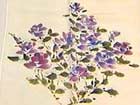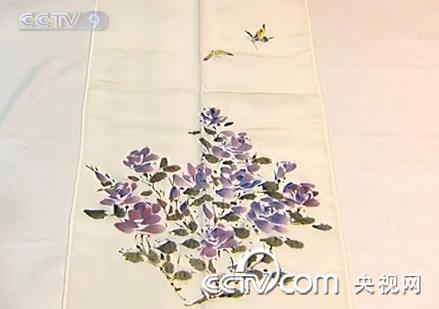| Videos | • Latest |
|
• Feature | • Sports | • Your Videos |
Silk painting, silk painter

Over the centuries, silk has become a Chinese symbol, and is often used as a gift to send to a foreigner, especially a hand-painted silk piece. Well, there's a particular Beijing resident that knows all about this. Xu Qing has been painting on silk for nearly thirty years. And her skill has been listed as an intangible heritage of Chongwen district. Next we meet this artist who creates beauty on the beautiful material silk.
In Chongwen district in east Beijing, there is a workshop called "Bai Gong Fang", which literarily means "workshop with a hundred kinds of handicrafts." Xu Qing is one of the signed artist here. She and her husband, a guard artifacts maker, work together in a studio within the workshop. Her silk works are displayed and sold here, and she also does demonstrations.
Xu Qing's silk painting attracted crowds during the Beijing Olympic Games, including the wife of International Olympic Committee President Jacques Rogge. Xu painted a scarf for her and put it around the madam's neck.
Silk scarves are Xu Qing's main type of work. The drawings on the scarves present Xu's mature skill in Chinese brushwork.
The Chinese roses on the scarves come in various colors and hues, and each piece is unique. The originality and individuality may explain why Xu's scarves are bought and collected by many people, some of whom frequent Xu's studio and become her fans.
Xu Qing, Silk Painter, said, "My skill satisfies individuality. The patterned cloth elsewhere are mostly printed, so they are mass produced. I paint the silk using some special dye. Although they are all painted by me, I draw each piece following my feelings. So basically they are all different. No two of them are totally the same."
Starting as a Gongbi painter, a delicate ink painting technique she learned from her father, Xu copied many ancient paintings when she was young.
Her father, Xu Yongkang, was the student of Gongbi master Tian Shiguang, and graduated from the prestigious National Beiping Art College.
Xu says these early artistic influences sparked her passion for painting.
Xu Qing, said, "My basic skills come from ink painting. I learned Chinese ink painting from my father starting from my childhood. My father was a graduate from the National Beijing Art College. I grew up immersed in paintings. Every year I cleaned up my father's boxes, looking at those vintage paintings, I kept asking him why I didn't see him painting them. My father said those paintings he'd drawn before weren't in vogue after liberation, because they were literati paintings. I asked if I could learn them. He said don't worry, step by step. I started learning painting at five or six years old, from simple ones. He scored for his students' homework, excellent, good, or five in grade. I said I would get his score too. He passed me a paper and said ok. Then he instructed me. That was the start of my learning."
Xu began silk painting in the 1980's, when her father set up a factory to produce hand drawn silk products.
Xu says the art is demanding, because the material is costly. A tiny mistake means the waste of a whole piece.
Xu Qing, said, "To draw on silk requires a mastery of your strokes. As the ancient saying goes "having a thorough picture already in mind." You should have that kind of feel. After I take a stroll in a park, I keep in my mind the images that I've seen. I learned this from my father, whose eyes were like a camera. He rarely did sketches on the spot. He kept the scenes in his brain, and painted them after returning home. Now to improve myself, I keep the flowers' shape and color in my mind when I stroll in a park. Then I can make them come to life with my brush back home."
 0
0 








Go to Forum >>0 Comments